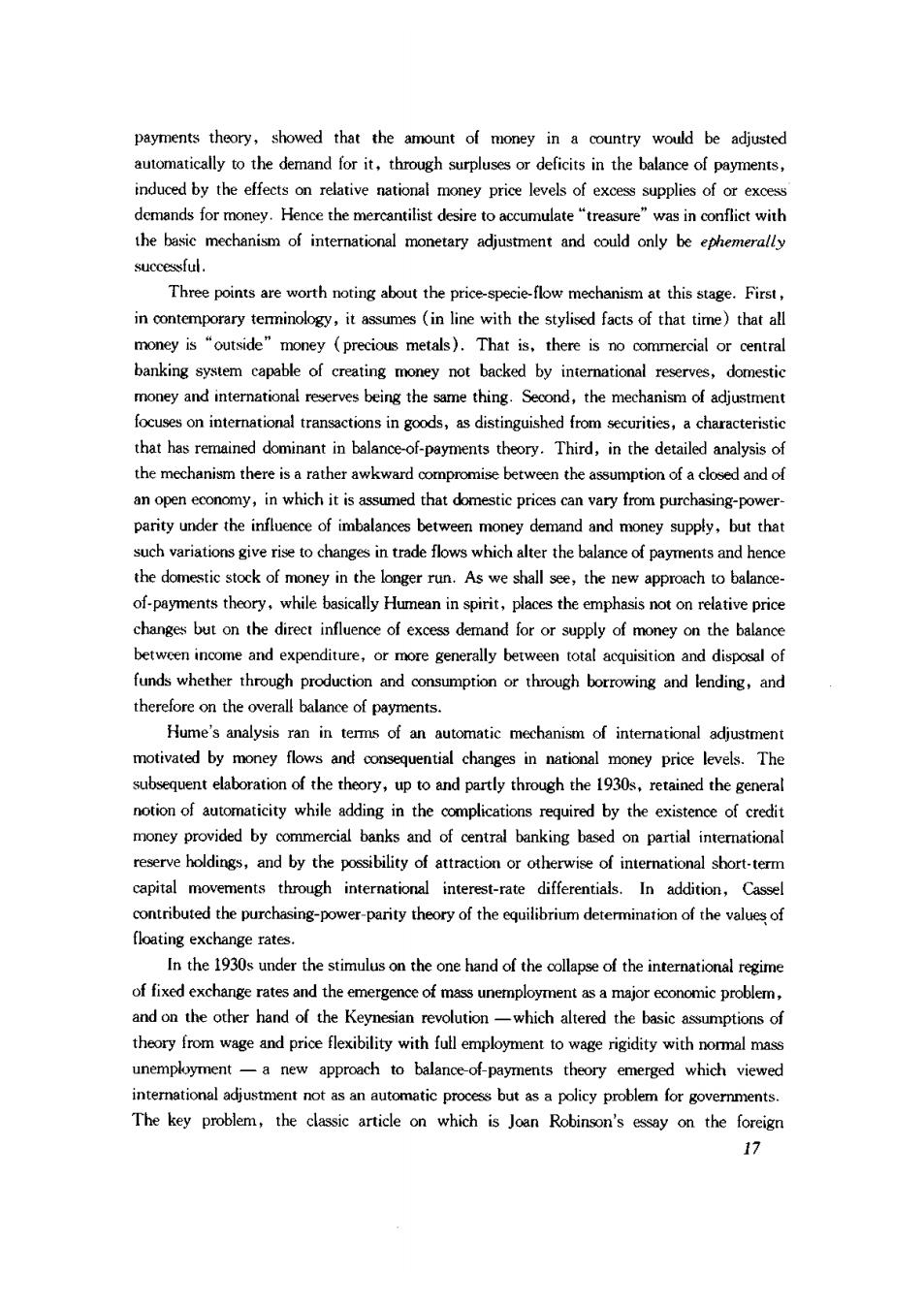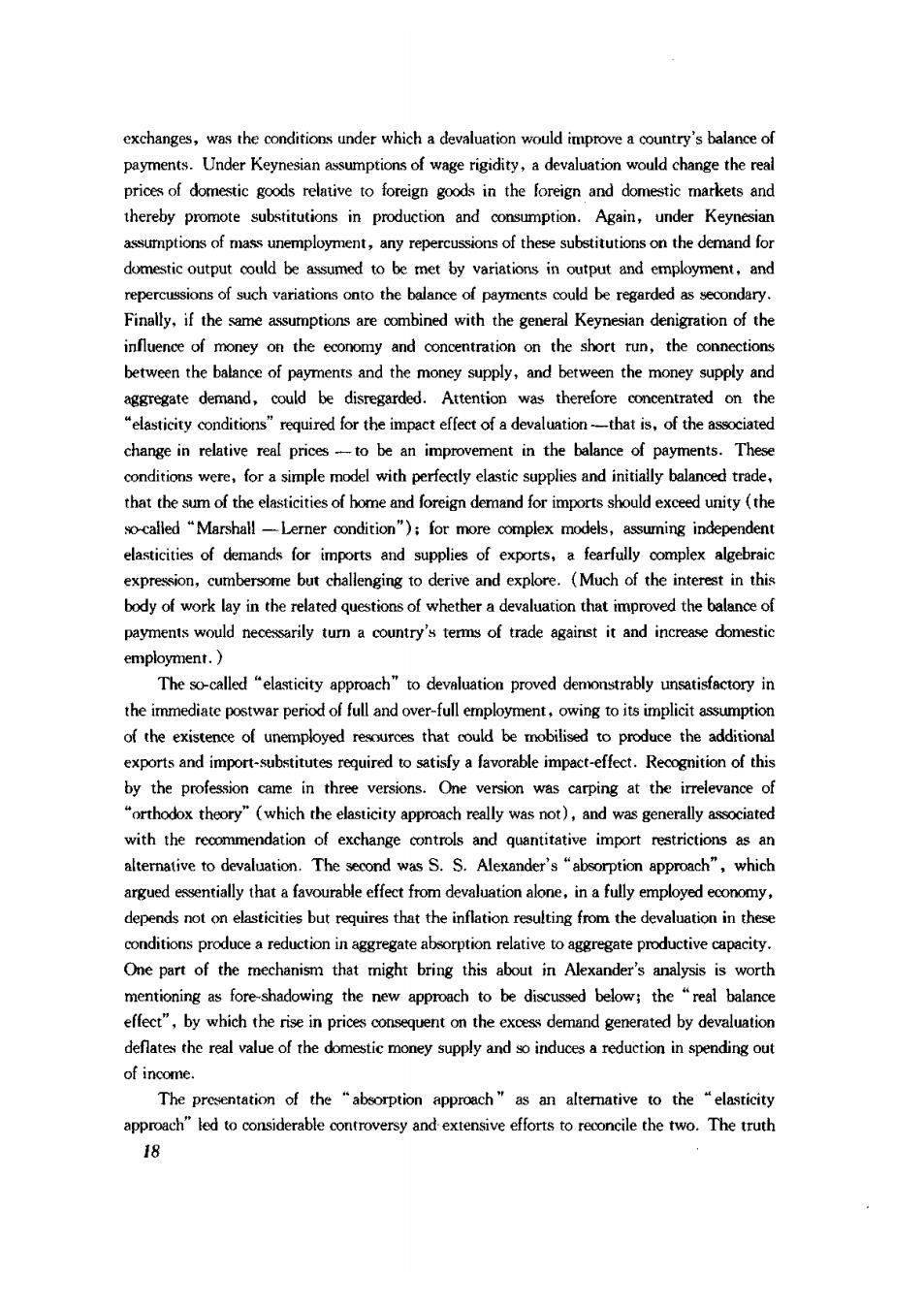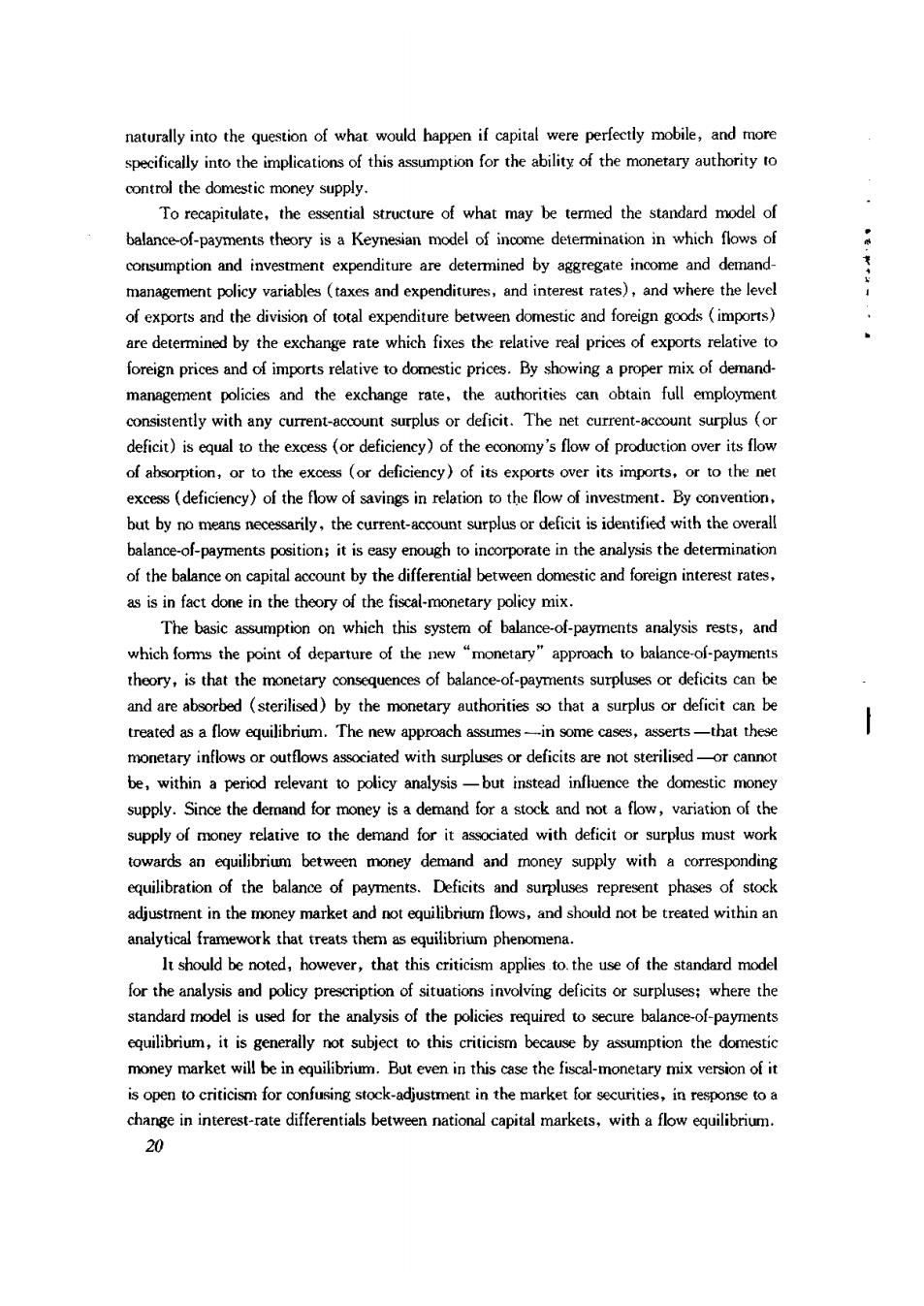
payments theory,showed that the amount of money in a country would be adjusted automatically to the demand for it.through surpluses or deficits in the balance of payments, induced by the effects on relative national money price levels of excess supplies of or excess demands for money.Hence the mercantilist desire toaccumulate"treasure"was with the basic mechanism of international monetary adjustment and could only be ephemerally successful. Three points are worth oting about the mechanism at this stage.First in contemporary terminology,it assumes(in line with the stylised facts of that time)that all money is "outside"money (precious metals).That is,there is no commercial or central banking system capable of creating money not backed by inernational reserves,domestic money and international reserves being the same thing.Second,the mechanism of adjustment focuses on international transactions in goods,as distinguished from securities,a characteristic that has remined dominant in balacf-ayments theory.Third,in the detailed the mechanism there is a rather awkward compromise between the assumption of a closed and of an open economy,in which it is assumed that domestic prices can vary from purchasing-power- parity under the influence of imbalanes betwee money demand and money supply,but tha such variations give rise to changes in trade flows which alter the balance of payments and hence the domestic stock of money in the longer run.As we shall see,the new approach to balance of-payments thory while the pric changes but on the direct influence of excess demand for or supply of money on the balance between income and expenditure,or more generally between total acquisition and disposal of funds whether and onsumption through borrowing and lending,and therefore on the overall balance of payments. Hume's analysis ran in terms of an automatic mechanism of international adiustment motivated by money flows and onsequential changes in national money price levels.The subsequent elaboration of the theory,up to and partly through the 1930s.retained the general notion of automaticity while adding in the complications required by the existence of credit reserve holdings,and by the possibility of attraction or otherwise of international short-term capital movements through international interest-rate differentials.In addition.Cassel the purchsingwer-parity theory of loating exchange rates. In the 1930s under the stimulus on the one hand of the collapse of the international regime of fixed exchange rates and the emergenceof and on the other hand of the Keynesian revolution-which altered the basic assumptions of theory from wage and price flexibility with full employment to wage rigidity with nommal mass unempkoyment a new approach to balance of-payments theory emerged which viewe intemational adijustment not as an automatic process but as a policy problem for governments. The key problem,the classic article on which is Joan Robinson's essay on the foreign

exchangeswas which a devaluation oud impve's balanceof payments.Under Keynesian assumptions of wage rigidity,a devaluation would change the rea prices of domestic goods relative to foreign goods in the foreign and domestic markets and thereby promote substitutions in production and consumption. Again,under Keyne assumptions of mass unemployment,any repercussions of these substitutions on the demand fo domestic output oould be assumed to be met by variations in output and employment,and cussions of such variations onto the balance of payments oould be regarded as Finally,if the same assumptions are combined with the general Keynesian denigration of the influence of money on the economy and concentration on the short run,the connections between the balance of payments and the money supply,and between the money supply and aggregate demand,could be disregarded.Attention was therefore concentrated on the "elasticity conditions"required for the impact effect of a devaluation-that is,of the associated change in relative real prices These conditions were,for a simple model with perfectly elastic supplies and initially balanced trade that the sum of the elasticities of home and foreign demand for imports should exceed unity (the erer ndition"for more complex mdels elasticities of demands for imports and supplies of exports,a fearfully complex algebraid expression,cumbersome but challenging to derive and explore.(Much of the interest in this payments would necessarily tur a country's ters of trade against it and increase domestic employment.) the immediate postwar period of full and over-full employment,owing to its implicit assumption of the existence of un mployed resoures that ould be mobilised to produce the additional by the profession came in three versions.One version was carping at the irrelevance of "orthodox theory"(which the elasticity approach really was not),and was generally associated with the reommendation of and quntitative import restrictions as ar alternative to devaluation.The second was s.S.Alexander's "absorption approach".which depends noton elasticities but requires that the inflation the devaluation n thes conditions produce a reduction in aggregate absorption relative to aggregate productive capacity. One part of the mechanism that might bring this about in Alexander's analysis is worth mentioning as fore-shadowing the new approach to be discussed below;the "real balance effect",by which the rise in prices consequent on the excess demand generated by devaluation deflates the real value of the domestie money supply and inducesa reduction in spending out of income. The presentation of the "absorption approach"as an altemative to the "elasticity to considerable onversy and extensive efforts to reconcile the two.The truth 18

apolicy instrument for orrecting a balanceof-payments deficit.It must use a combination of devaluation-to obtain an allocation of foreign and domestic demand among domestic and foreign output oonsistent with balance-of-payments equilibrium-and deflation to match aggregate domestic demand with aggregate domestic supply.More generally,it must use a proper oombination of what I have elsewhere called "expenditure-reducing"and"expenditure switching"policies.This general principle is developed at length in James Meade's classic book on The Theory of International Eemomic Policy:The Balance of Payments,though it was known before.It constitutes the third,and most useful,version of the recognition of the and the “absorption approach that is gically satisfactory (though not economically satisfactory from the point of view of the new monetary approach).Unfortunately,Meade his analysis in tems ofshort-rqrimalysis and tha the policy-makers understood the theory as well as he did,both of which characteristics made the book extremely inaccessible to policy-makers and may help to account for the bumbling of British demand-managempolicy after the.Also follwing the tradi of British central banking and moneary theory,Meade identified monetary policy with the fixing of the level of interest rates,a procedure that automatically excludes consideration of the monetary cons devaluation by assuming them to be absorbed by the monetary authorities (this is the reason for the economic objection to the Meade synthesis mentioned abave) Subsequent to the work of Meade and others in the 1950s,the main development in conventional balance-of-payments theory has been the development of the theory of the fiscal monetary policy mix following the.A.Mundell.In the ge era logic of the Meade has tohave two policy instruments if it is toachieve simultaneously internal and external balance (full employment and balance-of-payments qulibrium).In Meade's system,the instrumentsare demand manag ent by fiscal and/or monetary policy,and the exchange rate(wage-price flexibility).What if wage are rigid,and controls and exchange-rate changes are ruled out by national and international political considerations?A solution can still be found,at least in principle,if capital is rate differentials.Fiscal expansion and monetary expansion then have the same effects on the current account,increasing imports and possibly decreasing xports,but the capital:fiscal expansion increse rest rates and attracts a capital inflow while monetary expansion has the opposite effect;it follows that the two policies can be"mixed"so as to achieve a capital acoount surplus or deficit qa to the current acot deficitor the level of full employment of the coonomy. This extesion of the Meade approch has lent infinite mathemtica product differentiation,with little significant improvement in quality of economic product,and will not oncer us further except to note that theoretical investigation of the model led

naturally into the question of what would happen if capital were perfectly mobile,and more specifically into the implication of thisassumption for the ability of the monetaryauthorityto control the domestic money supply. To recapitulate,the essential structure of what may be termed the standard model of balance-of-payments theory isa Keynesian model of inme determination n which fows of consumption and investment expenditure are determined by aggregate income and demand management policy variables (taxes and expenditures,and interest rates),and where the level the expenditure between domesticand() are determined by the exchange rate which fixes the relative real prices of exports relative to foreign prices and of imports relative to domestic prices.By showing a proper mix of demand management policies and the exchange rate.the authorities can employme consistently with any current-account surplus or deficit.The net current-account surplus (o deficit)is equal to the excess (or deficiency)of the economy's flow of production over its flow or to the net excess (deficiency)of the flow of savings in relation to the llow of investment.By convention but by no means necessarily,the current-account surplusor deficit is identified with the overall of the balance on capital account by the differential between domestic and foreign interest rates as is in fact done in the theory of the fiscal-monetary policy mix. The basic assumptionon which this system of balance-of-payments analysisrests,and which forms the point of departure of the new "monetary"approach to balance-of-payments thoory,is that the balance-of-payments surpluseso deficits can be and are aborbed (sterilised)by the monetary authoritieso that a surplus or treated as a flow equilibrium.The new approach assumes- -in some cases,asserts-that these monetary inflows or outflows associated with surpluses or deficits are not sterilised- be. within a period relevant to plicy but instead inflence the domestic mone supply.Since the demand for money is a demand for a stock and not a flow,variation of th supply of moey relative to the demand for it associated with deficit or surplus must work rds an quilibrium between money demand and money supply equilibration of the balance of payments.Deficits and surpluses represent phases of stock adjustment in the money market and o flows,and should not betreated withinan ork that treats them phenomena It should be noted,however,that this criticism applies to.the use of the standard model for theanalysis and policypr sta ndard model is used or the analysis of the policies rquired cure balance-of-payment equilibrium,it is generally not subject to this criticism because by assumption the domestic money market will.But even in this case the fiscal-monetary mix versionofit is open to criticism for confusing stock-adjustment in the market for securities,in change in interest-rate differentials between national capital markets,with a flow equilibrium. 20

deficitsor the basis of in the money market (and also possibly the securities market),it is necessary to construct a model in which the need for stock adjustments is being continuously re-created by economic change- growth is going on.This is one of the important technical differences between the new "monetary"models of the balance of payments and the standard Keynesian model-and a potentour of difficulty in omaring the the two types of analysis A further difference between the two types of models is that the "monetary"models almost invariably assume-in contrast to the emphasis of the standard model on the influence of relative priceso trade flows-thaaury's price level is pegged to the levelad must move rigidly in line with it.One justification for this assumption is that,at least among the advanced industrial countries.industrial competition is so pervasive that elasticities of infinity than to the relatively low numbers implicit in the standard model.Another and more sophisticated justification is derivable from the general framework of the monetarist approach, process of stock-adjustment to monetary disequilibrium and that in the longer-run analysis of balance-of-payments phenomena among growing economies attention should be focused on ng- -which for simplicity can mos This point has sometimes been put in terms of the positive charge that the standard model rests on"money illusion",in the sense that it assumes that workers will accept a reduction in form of a forced reduction of domestic money wages.An alternative version of this charge is that the standard model assumes that workers can be cheated out of their real marginal product by devalation.The charge,however,rectifictionbaef-pay deficit requires that the domestic marginal product of labour in tems of foreign goods falls because the price of domestic goods relative to foreign goods must be reduced in the foreign and home marketso induce substitution between these gods favourable to the balance payments,it requiress no money illusion but only economic realism for the workers to accept this fact.Applications of the standard model to the case of devaluation,however,do require the assumption of mon and foreigr goods are in fact high (approximately infinite),and it is nevertheless assumed that wages will remain unchanged in terms of domestic currency.For in this case it is being expected that workers will be content oaccept wages below the intem of their marginal product, and that emplovers will not be driven by competition for labour in the face of this disequilibrium bid wages upto their margina productivity levels.The issue therefore of the e workers. but of its possibly wrongly assuming low elasticities of substitution between domestic and foreign goods-which is an error in empirical assumptions rather than in model construction. 21